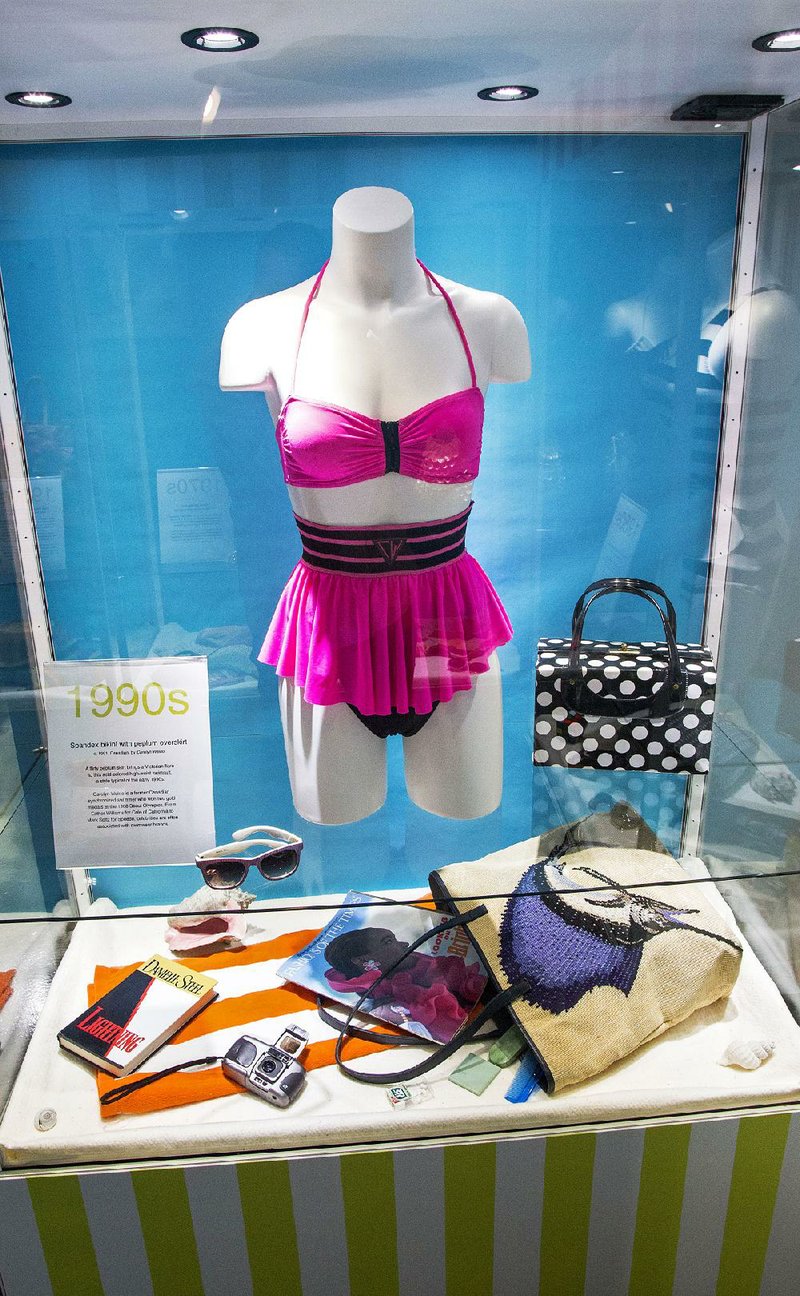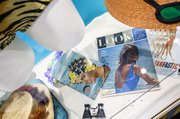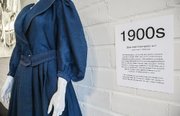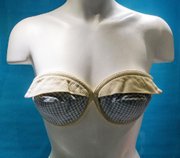Since 2013, the Esse Purse Museum in Little Rock has been exploring the history of the American woman through her purses. This summer, the museum is taking the plunge to explore that same history, but this time through a special exhibit on a century's worth of swimwear.
With the mercury rising and vacation trips abounding, it seems only fitting that a day of summer fun include a trip to explore "Changing Tides: 100 Years of Iconic Swimwear." The exhibit, which opened in mid-May, continues through Aug. 7.
Esse Purse Museum & Store
1510 S. Main St., Little Rock
Hours: 11 a.m. -4 p.m. Tuesday-Saturday; 10 a.m.-3 p.m. Sunday. Closed Monday
Admission: $10; $8 for senior citizens, students and military; free for ages 6 and younger
(501) 916-9022, essepursemuseum.com
Esse, believed to be one of only three such museums in the world (there's one in Amsterdam and another in Seoul, South Korea) and the only one in the United States, is a social history museum which strives to share the story of 20th-century women through their purses and accessories. The permanent exhibit is divided into large display cases -- one for each decade of the century.
"We're telling the history of women through a look at the purses they carried and the things they carried in them," says the museum's founder Anita Davis about the large personal collection she amassed during more than two decades before opening Esse on South Main in downtown Little Rock. Esse means "to be" in Latin and signifies Davis' belief that a purse contains the essence of the true being of a woman.
In addition to the purse exhibit, the special visiting swimwear exhibit highlights iconic women's garments -- from homemade to haute couture -- worn to beaches and pools. The installation features bathing suits, which are on loan from the collection of the Fashion History Museum in Cambridge, Ontario, accented with some beach-related accessories from the Esse museum.
Diving deeper
"I consider this to be sort of an archaeological adventure," Davis says. "There are lots of stories being told in them, from the fabric the suits are made of to the styles in which they're designed."
The swimwear exhibit is presented in a smaller adjoining area of the museum in cases with beach cabana imagery.
The earliest suits of the 20th century for women mainly consisted of a blouse, skirt and knickerbockers, made of mohair silk, silk taffeta or wool. Accessories often included colored stockings (often black), fancy caps,
parasols and cork-soled sandals or lace-up bathing slippers for walking on the hot sand.
The bathing costume representing the first decade of the 1900s is blue wool while the one for the 1910s is black cotton with red-and-white trim , red buttons, black-and-white striped trim on the collar and sleeves and a belt. The 1920s suit is a brown silk pageant suit with coral silk trim and matching hat and bow.
Early swimwear didn't resemble modern swimsuits . It reflected fashions of the period. That began to change after Australian swimmer Annette Kellerman, who visited the United States in 1907 to perform as an "underwater ballerina," wore form-fitting swimming tights and was arrested on a beach in Boston for indecent exposure for revealing her legs, arms and neck. By 1910, Kellerman's style had become popular in parts of Europe but not in this country, where swimwear continued to look like dresses. Hemlines were rising, however.
In 1918, at least one company, Jantzen, was making knitted swimsuits in a unisex style. By the 1930s, more streamlined suits became popular as evidenced by a Jantzen green wool suit. By this point, suntans had become popular and many suits featured detachable straps and low-cut backs for maximum skin exposure.
Drifting into uncharted territory
In the late 1930s, midriff-baring two-piece suits had come on the scene.
"They were not bikinis as they did not show the belly button," Davis explains.
Lastex -- a stretchy material of nylon, silk or wool combined with elastic -- was introduced in 1932 for girdles and makes an exhibit appearance in a 1946 swimsuit.
The bikini -- which debuted in France in 1946 but was generally banned from public wear -- is represented in a 1959 blue gingham suit titled Brigitte Bardot by Lovable, a company that originally made brassieres. The suits, which began appearing on beaches in Europe in the 1950s, didn't arrive here in the United States until Sandra Dee's 1959 film Gidget hit theaters.
In 1965, Cole of California took it further, producing their Scandal Suit with fishnet panels exposing flesh with opaque spandex concealing certain areas.
"This was very risque back in the 1960s," Davis says.
The 1970s included "barely there" swimwear like string bikinis and velour bathing suits by designers such as Oleg Cassini. By the 1980s, a fitness-conscious society led to suits designed for highly toned bodies with features such as high-cut legs.
Styles resurface
In her 41 years in the business, Barbara Graves who owned and operated an intimate apparel store in Little Rock from 1973 until her 2014 retirement, has seen styles of swimwear evolve. When contacted for this feature, she hadn't yet seen the exhibit but said she plans to do so.
From the start of her business, Graves says she sold swimwear.
"When I first opened in the early 1970s, Bali and Vassarette did the bra size tops and bottoms in sizes of small, medium, large and extra large," she says. "After a few years, that system went away and I got into the ready-to-wear swimsuits but then 30 years later, I watched that whole market [of sizing] come back again."
Graves says because of the lingerie nature of her business, fit was paramount whether it was underwear or a swimsuit.
She added that she always focused on quality swimsuits that emphasized fit and function because so many Arkansans are active at the lake.
"They don't want their swimsuit to fall off," Graves says, chuckling. "They want containment, one that's opaque, and one that has what I call beefy fabric that has some control in it."
She says she has seen many styles come and go: "I saw swimsuit covers became a category by itself as people became more sensitive to the aspects of the sun. Sometimes, more coverage with higher-neck suits and hats, sunglasses, cover-ups that covered up not just the suit but also for sitting out in the sun. Back in 1973, a cover-up was almost non-existent. Back then, we just put on cut-off jean shorts and maybe a T-shirt."
Graves says she has also seen some swim fashions return. The 1990s brought styles featuring a flirty peplum skirt, reminiscent of early Victorian-era swimwear that resembled dresses and included skirts.
Reaching historic depths
Johanna Miller Lewis, professor of history and associate dean of history at the University of Arkansas at Little Rock, recently viewed the swimwear exhibit when she was at the museum giving a talk on purses throughout history.
"I'm usually pretty critical of museums and I've got to tell you, that thing is a gem," she says of the museum and the swimwear exhibit. "It's not a lot of space but it was perfect for that little traveling exhibit on the bathing costume swimwear. The exhibit is great and also tells the story of women's history through the costumes. The historian in me is always thinking, 'What is this stuff made of? How has it been sewn?' And there's an entire history there of technology and fashion because you start out with natural fibers like cotton and wool, then there are mixed fabrics, then latex and elastic, and then they bring it all the way up to the present day."
"I often tell students when I teach my class on doing history with objects that it's just like reading a document if you learn the language," she says. "If you learn the language of style, design and materials, there are all sorts of layers there; it's also the history of technology and, to a certain extent, it's also American history."
Style on 07/12/2016





